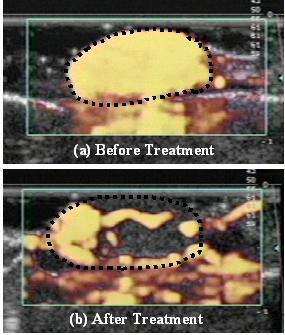Scientists at the University of Pennsylvania have succeeded for the first time in using ultrasound to treat cancer in animals, using Shattering the blood vessels that feed the cancerous tumor
Ben Asio

These images were obtained by ultrasound imaging (after intravenous injection of contrast material) of subcutaneous melanoma cancer in a mouse. The image above shows the tumor before treatment while the one below shows it after being treated with the innovative method. Blood flow is represented as a yellow color. It can be observed that the blood flow to the cancerous tumor after the treatment was disrupted while the blood flow to the surrounding tissues was preserved.
Scientists at the University of Pennsylvania have succeeded for the first time in using ultrasound to treat cancer in animals, using Shattering the blood vessels that feed the cancerous tumor. Researchers from the University of Pennsylvania School of Medicine completed a study in mice in which they used ultrasound to locate the distribution of blood vessels in the tumor and also to treat it with continuous low-frequency ultrasound waves.
After three minutes of treatment with the same intensity as that used in physical therapy (2.5 watts), the researchers discovered that the tumor had lost almost all of its blood.
Prof. Chandra Siegal, head of ultrasound research in the radiology department of "Penn" Medical School:
"We used an ultrasound intensity higher than that used for imaging, but much lower than that used for tissue vaporization in surgery. We discovered that the use of such power has a strong effect that blocks the flow of blood to the cancerous tissue and halts its development in mice."
Prof. Andrew Wood, another scientist from the School of Veterinary Medicine of the University of Pennsylvania participating in the study adds:
"We wanted to learn about this use of ultrasound after we noticed that some of the new blood vessels that are formed by tumors are quite weak by nature and when low-intensity ultrasound waves are aimed at them, it is possible to disrupt the blood flow to them."
Siegel adds: "This is an approach that is on par with the latest research in cancer treatment using anti-organic and anti-vascular therapies in which we are looking for ways to stop the development of blood vessels in tumors. And this, compared to other methods in which they try to eliminate the tumor directly."
For years, ultrasound has been used in the clinical field for imaging and therapy, but now, the latest results are extremely encouraging, because they raise the possibility that in the future it will be possible to treat cancer using ultrasound or combining it with chemotherapy and anti-vascular therapy."
